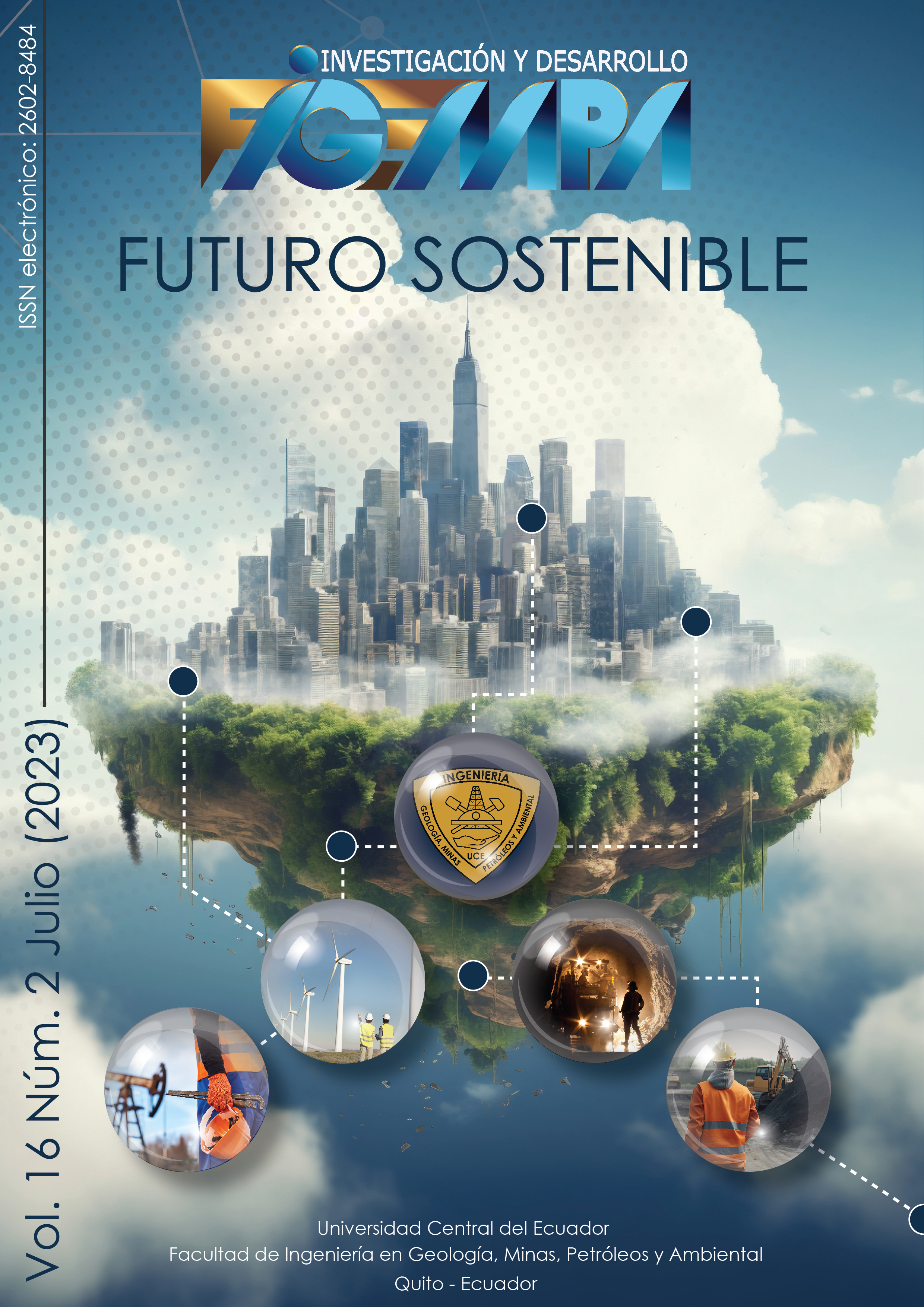Environmental damage and circular economy in the exploitation of non-renewable natural
Main Article Content
Abstract
Ecuador needs a cultural, economic, social and environmental change; in waste management and production policies. The research objective is that the State must adhere to the rules and principles of Circular Economy. Given the negative environmental damage caused by productive activities in general and in particular in Protected Areas, aquatic and terrestrial ecosystems of the country. With 19.1 million hectares of Protected Areas (AP); This means that about 20% of the territory corresponds to 59 zones; where the Ministry of the Environment (2019) focuses on cases considered examples of mining, with the objective of guaranteeing and protecting biodiversity and the well-being of all living beings, carrying out the management, regulation and distribution of economic resources according to the 2008 Constitution. The investigative methodology is systemic of causality and effects of Environmental Damage, by intervention that corresponds to the productive activity, whatever the economic sector that intervenes, such as modern mining, it is considered that man has always used natural resources, seeking to improve his existence. The results are in Preventing and mitigating the damage and destructive impact of human activities on natural resources; nature cannot be restored or replaced in the near future and leads to depletion, in violation of the laws of the natural environment. Two cases of extractive exploitation of resources such as Yasuní and LLurimagua are also considered. In conclusion, it is necessary to consider and apply environmental regulations and mechanisms that minimize impacts and allow their regeneration.
Downloads
Metrics
Article Details

This work is licensed under a Creative Commons Attribution 4.0 International License.
References
Asamblea Nacional (2008) Constitución de la República del Ecuador. https://www.gob.ec/sites/default/files/regulations/2020-06/CONSTITUCION%202008.pdf
Bedón Garzón, R. (2011). Aspectos procesales relativos al daño ambiental en el Ecuador. Ius Humani. Revista de Derecho, 2 (2010/2011), 9-41. https://dialnet.unirioja.es/descarga/articulo/4999986.pdf
Calderón Gamboa, J. F. (2013) La evolución de la "reparación integral" en la jurisprudencia de la Corte Interamericana de Derechos Humanos. ISBN 9786077290490 https://searchlibrary.ohchr.org/record/24783
Cámara Valencia (2008) La ecoeficiencia. Cuaderno de Comercio y Sostenibilidad. https://www.camaravalencia.com/wp-content/uploads/2023/01/cuaderno_ecoeficiencia.pdf
Cortés-García, F. J. (2020) La economía circular. Ideas claves para la compresión de un nuevo modelo. Santiago, Chile: Registro de propiedad intelectual: 2020-A-3178. http://dx.doi.org/10.32457/ISBN9789568454708692020-ED1
Guaranda Mendoza, W. (2010) Estudio comparado de derecho ambiental: Ecuador, Perú, Bolivia, España: énfasis en Parámetros de Calidad y Límites Máximos Permisibles dentro de Actividades Extractivas. (1 Ed.) Quito: Fundación Regional de Asesoría en Derechos Humanos. ISBN 9789978980217
Ley De Minería (29 de enero de 2009). Ley 45. Registro Oficial Suplemento 517 Quito. https://www.enamiep.gob.ec/wp-content/uploads/downloads/2020/08/LEY-DE-MINER%C3%8DA.pdf
MAATE (2022) Ministerio del Ambiente, Agua y Transición Ecológica. https://www.ambiente.gob.ec/
MAE (2012) Sistema Nacional de Áreas Protegidas. http://areasprotegidas.ambiente.gob.ec/
MAE (2019) Sistema Nacional de Área Protegidas. Boletín final Sistema Nacional de Indicadores Ambientales y Sostenibilidad –SINIAS. Ministerio de Ambiente del Ecuador. https://www.ambiente.gob.ec/wp-content/uploads/downloads/2020/04/2020_03_30-BOLETIN-FINAL.pdf
Maleaba, J. & Castelo Branco, J. (2004) Ecuador: el Parque Nacional Yasuní en peligro por actividades petroleras de Petrobrás. Movimiento Mundial por los Bosques Tropicales. https://www.wrm.org.uy/es/articulos-del-boletin/ecuador-el-parque-nacional-yasuni-en-peligro-por-actividades-petroleras-de-petrobras
Mataix González, C. (2010) Movilidad Urbana Sostenible: Un reto energético y ambiental. https://www.fenercom.com/publicacion/movilidad-urbana-sostenible-un-reto-energetico-y-ambiental-2010/
Ministerio del Ambiente (2004) Ley Forestal y de Conservación de Áreas Naturales y Vida Silvestre. https://www.ambiente.gob.ec/wp-content/uploads/downloads/2015/06/Ley-Forestal-y-de-Conservacion-de-Areas-Naturales-y-Vida-Silvestre.pdf
Ministerio del Ambiente, Agua y Transición Ecológica (2017) Código Orgánico del Ambiente - COA. https://www.ambiente.gob.ec/wp-content/uploads/downloads/2018/01/CODIGO_ORGANICO_AMBIENTE.pdf
Ministerio del Ambiente, Agua y Transición Ecológica (2022) El Programa de Reparación Ambiental y Social (PRAS) del Ministerio del Ambiente, Agua y Transición Ecológica. http://pras.ambiente.gob.ec/inicio.
MPCEIP (2021) Libro Blanco de Economía Circular de Ecuador. p. 116. https://www.produccion.gob.ec/libro-blanco-de-economia-circular-de-ecuador/
ONU (1992) Declaración de Río sobre el Medio Ambiente y el Desarrollo. http://www.lacult.unesco.org/docc/1992_Declaracion_Rio_principios.pdf
Paz-Cardona, A.J. (2019) Nuevo estudio muestra que industria petrolera habría deforestado más de lo permitido en el Parque Yasuní. https://es.mongabay.com/2019/12/petroleo-en-el-yasuni-aumenta-deforestacion-ecuador/.
Peña Chacón, M. (2013) Daño Ambiental y Prescripción. Revista Judicial, 109, 118-143. https://escuelajudicialpj.poder-judicial.go.cr/Archivos/documentos/revs_juds/Revista%20109/PDFs/07_danio_ambiental_prescripcion.pdf
PNUD (2017) Informe sobre Desarrollo Humano 2016. https://www.undp.org/es/publications/informe-sobre-desarrollo-humano-2016
Poveda Bonilla, R. (2021) Estudio comparativo de la gobernanza de los conflictos asociados a la minería del cobre en Chile, el Ecuador y el Perú. CEPAL. https://repositorio.cepal.org/handle/11362/47569
Rea Toapanta, A. R. (2017) Política minera y sostenibilidad ambiental en Ecuador. FIGEMPA: Investigación Y Desarrollo, 4(2), 41–52. https://doi.org/10.29166/revfig.v1i2.68.
Secretaría de Medio Ambiente y Recursos Naturales (2018) Seguridad ambiental, pilar de la conservación. https://www.gob.mx/semarnat/articulos/seguridad-ambiental-pilar-de-la-conservacion
Senplades (2012) Plan Nacional de Descentralización 2012-2015. Registro Oficial Nº 673 de 30 de marzo del 2012 https://www.planificacion.gob.ec/wp-content/uploads/downloads/2012/08/Plan-Nacional-de-Descentralizaci%C3%B3n-2012-2015.pdf
Vasco, G. (2020) El Ecodiseño En La Economía Circular. Secretaría General de Acción Exterior.
Vásconez Carrasco, M. & Torres León, L. (2018) Minería en el Ecuador: sostenibilidad y licitud. Revista Estudios del Desarrollo Social: Cuba y América Latina, 6(2), 83-103. http://scielo.sld.cu/scielo.php?script=sci_arttext&pid=S2308-01322018000200006&lng=es&tlng=es.
Vilela Pincay, W., Espinosa Encarnación, M. & Bravo González, A. (2020) La contaminación ambiental ocasionada por la minería en la provincia de El Oro. Quito: Universidad Andina Simón Bolívar, Corporación Editora Nacional. http://hdl.handle.net/10644/7911

